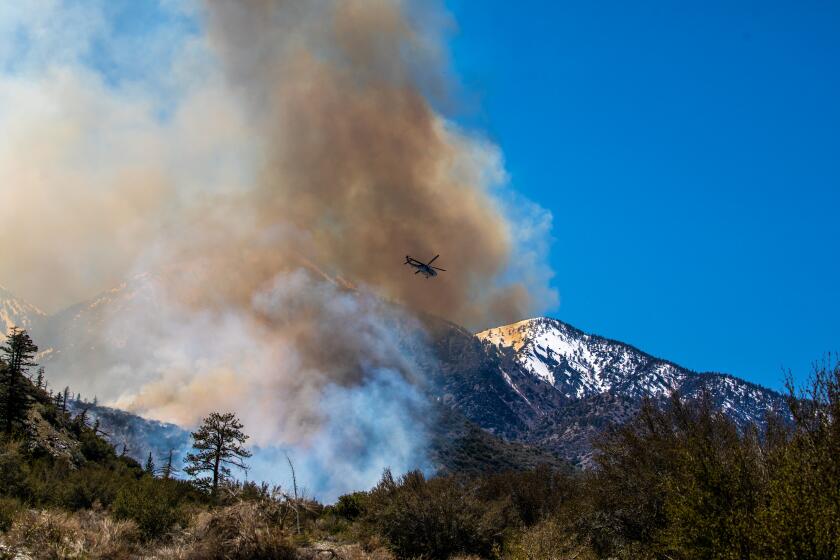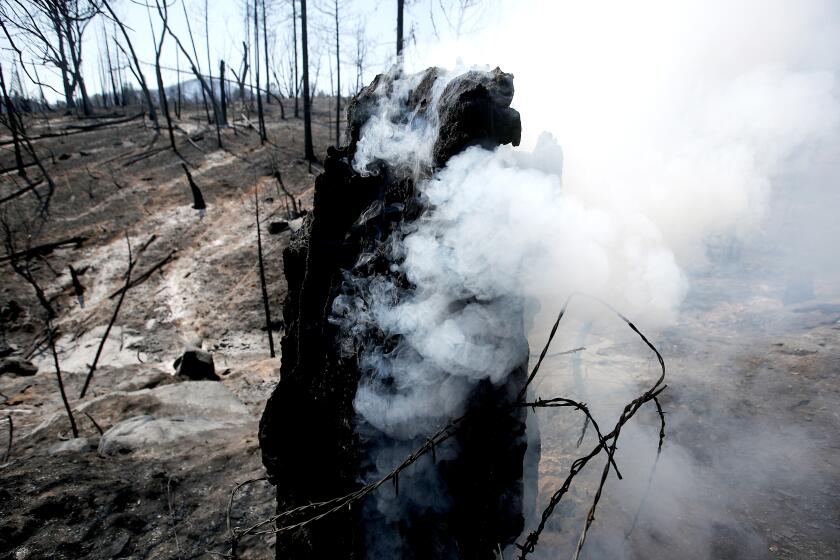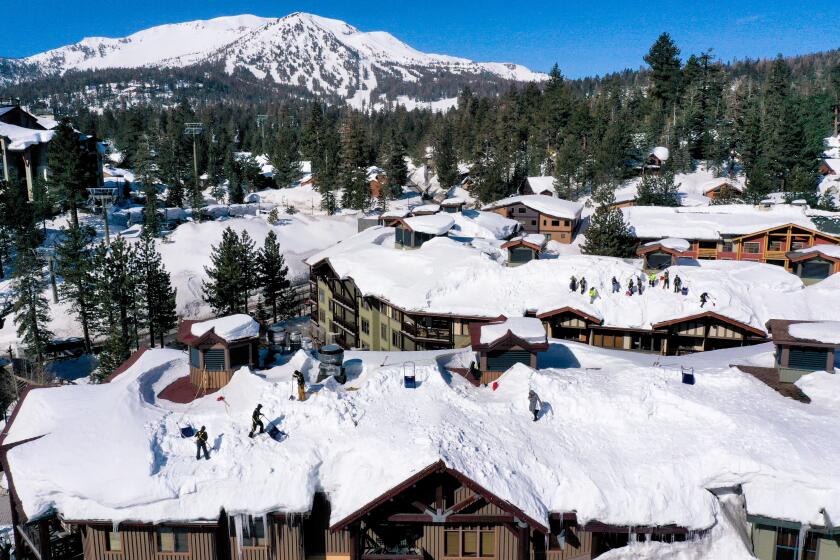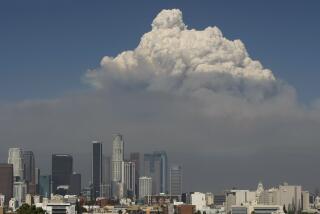Almost 40% of land burned by western wildfires can be traced to carbon emissions
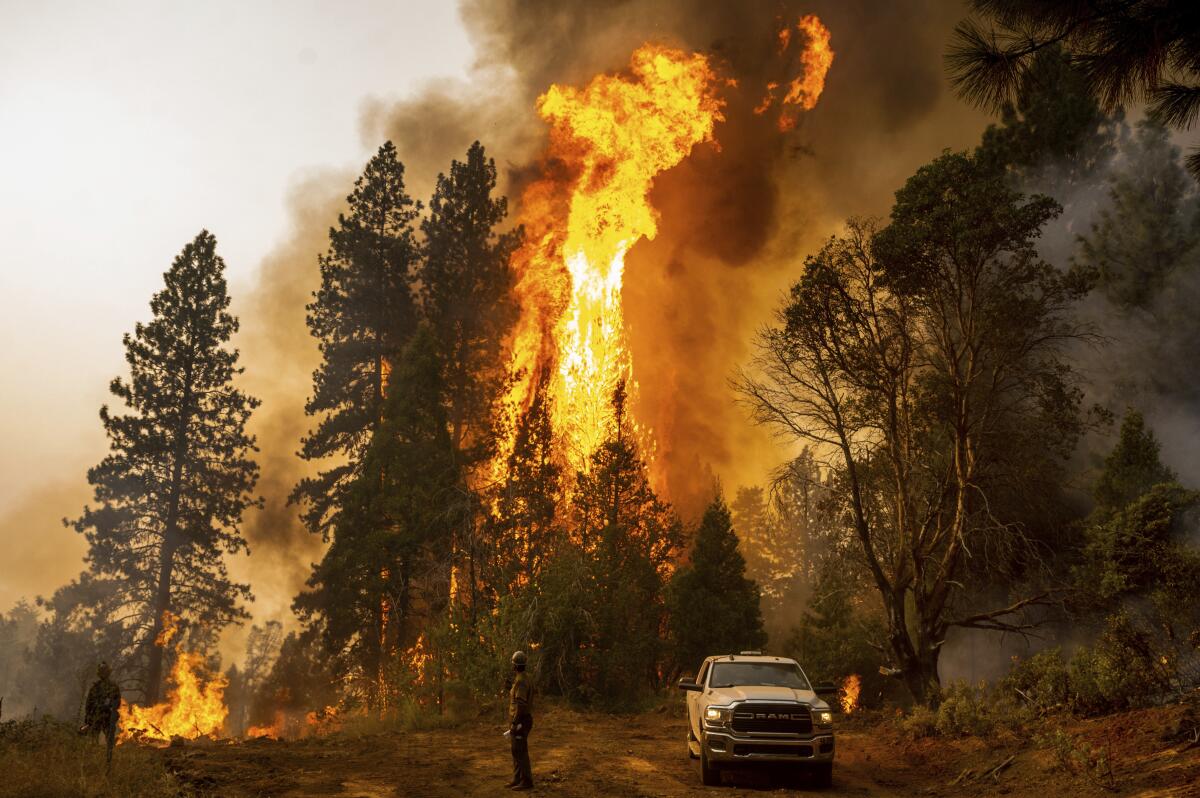
Almost 40% of forest area burned by wildfire in the western United States and southwestern Canada in the last 40 years can be attributed to carbon emissions associated with the world’s 88 largest fossil fuel producers and cement manufacturers, according to new research that seeks to hold oil and gas companies accountable for their role in climate change.
In findings published Tuesday in the journal Environmental Research Letters, the authors concluded that the emissions generated in the extraction of fossil fuels, as well as the burning of those fuels, have increased the amount of land burned by wildfire by raising global temperatures and amplifying dry conditions across the West. This growing dryness, or aridification, has caused the atmosphere to become “thirstier” for water, draining moisture from trees and brush and causing them to become more vulnerable to fire, the researchers say.
The study is the latest in a growing body of research known as extreme event attribution, or attribution science, which seeks to determine how much global warming has contributed to events such as heat waves, droughts and wildfires.
“We hope that people who are in communities that have been affected by wildfires will see this work and think about whether they want to hold these companies accountable,” said study author Kristina Dahl, principal climate scientist with the Union of Concerned Scientists.
Forecasters say portions of California could get a break this wildfire season, but at lower elevations the outlook is uncertain.
To quantify the impact of the fossil fuel industry on wildfires, Dahl and her colleagues built on previous research that has shown that carbon emissions traced to the top 88 fossil fuel producers and cement manufacturers — including Exxon Mobil, BP, Chevron and Shell — have contributed significantly to the average temperature by which the Earth has warmed. (Cement production is responsible for 8% of human-generated carbon dioxide — significantly less than the burning of fossil fuels.)
The researchers found that changes in global mean temperature are positively linked with changes in the Western North American vapor pressure deficit, a measure of how effectively the air can dry out plants and vegetation that ultimately become fuel for wildfires, Dahl said.
“I actually laughed because I’ve never had such a strong correlation in my data before,” she said.
The researchers were then able to estimate that emissions from the major carbon producers contributed to 48% of the increase in the vapor pressure deficit observed over the last 120 years. Previous research has shown that this rise is strongly associated with an increase in burned forest lands in the western U.S. and southwestern Canada.
From there, the researchers found that the emissions were responsible for 37% of the 53 million acres of forest area — or 19.8 million acres — burned by wildfire since 1986.
The results don’t account for the effects of non-climate factors, including fire suppression, the prohibition of Indigenous burning and increases in human-sparked fires associated with more people moving into wilderness areas, which have played a role in driving the size and severity of individual fires, but have not affected the relationship between climate and burned area, the study notes.
Asked to comment on the findings, a spokesman for the Western States Petroleum Assn. said that “demonization” of the fossil fuel industry would not bring solutions.
“We all want the same thing: affordable, reliable and ever-cleaner energy and fuels,” Kevin Slagle wrote in an email. “A press release from a well-funded activist group with a long history of attacking energy industries is unhelpful to the serious and realistic climate and energy policy discussions needed to get us there.”
Members of the Southern Sierra Miwuk Nation became the latest Indigenous tribe to watch homes burn despite knowing it could have been avoided.
Up until relatively recently, the public posture of the climate science community was that no individual extreme event could be attributed to global warming, said Noah Diffenbaugh, climate scientist at Stanford University’s Doerr School of Sustainability, who was not involved in the study. That changed in the early 2000s, and extreme event attribution has since become a robust sub-field of climate science, he said.
Although the sub-field does not exist to provide data for legal actions, it in some ways arose from questions of law, he said. Some of its earliest examination in scholarly literature was in law review articles about the need to quantify the contribution of historical global warming to individual events for the purposes of assigning liability, he said.
Since then, attribution research has served as a foundation for liability lawsuits filed against fossil fuel companies.
Last month, in what was seen as a major victory for plaintiffs, the U.S. Supreme Court declined to hear appeals from oil and gas companies that were seeking to have lawsuits over climate change filed by state and local governments moved to federal courts. The decision cleared a path for dozens of similar lawsuits to be heard in state courts, where communities that are suing are believed to have better chances of winning sizable damages.
“What this study shows is that using existing peer-reviewed methods, it is possible to rigorously trace the contributions from the source of emissions to the impacts,” Diffenbaugh said.
Another scientist who was not involved with the study said the authors’ methodology appeared sound.
Rong Fu, the director of the UCLA Joint Institute for Regional Earth System Science and Engineering, has also studied the link between global warming and increasingly destructive wildfires. If anything, study authors might have underestimated the impacts of the companies’ emissions because they included aerosol emissions in their calculations, Fu said.
Aerosols — small particles in the air that can come from the burning of fossil fuels — tend to cool surface temperatures, she said. But these emissions have shorter lifetimes, and they tend to decrease as technology improves, she said. As that happens, we are likely to see a stronger warming, she said.
“This paper really takes to the next level that linking of these increases in wildfires to the main emitters in the world,” Fu said.
Flying over the Sierra Nevada, teams are using lasers to measure California’s vast snowpack, tracking flood risks as the snow melts.
When considering the connection between fossil fuels and extreme events, Dahl said it was important to recognize that the impacts of climate-driven disasters have not been borne equally.
As wildfires in the western U.S. have grown in size and intensity, and wrought unprecedented levels of damage on communities, the public has been left to cover much of the cost through higher taxes and utility bill surcharges, she said.
“But at the same time, we know the fossil fuel industry has known for decades what the impact of their products would be on our climate, and that emissions associated with those companies have significantly altered our climate,” she said. “We really wanted to put a spotlight on the fossil fuel industry’s role in driving the West’s worsening wildfires so they can be held accountable for their share of the costs.”
“I think a lot of us in California are used to thinking about corporate accountability for wildfires as just being limited to Pacific Gas & Electric Co. and the immediate utility failures that have sparked some of the state’s largest and deadliest wildfires,” she added. “But the reality is there’s this much bigger set of corporate actors who have not been held accountable at all.”
